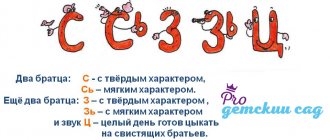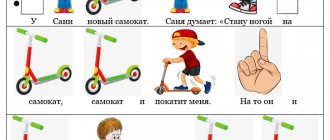In elementary grades, children often hold writing utensils incorrectly while completing assignments in class. And this is fraught with many problems in the future. It is better to form a correct grip of a pen and pencil in a child even in preschool age. The most favorable period for this is 3–4 years.
- 2 How to understand that a child is holding a pen incorrectly
2.1 Gallery: incorrect grip of a pen and pencil
- 4.1 Gallery: ways to form the correct grip of a pen and pencil
Why do children hold pens and pencils incorrectly?
The child’s grasping reflex develops already in infancy, and by the age of one year the baby can confidently hold various objects with his hand. Most often, it is clenched in a fist. This is convenient for him, he sees that with such a “grab” the toy, spoon or pencil does not fall. Even if a child is observant and notices that adults hold a pencil differently, it is not easy for him to repeat this due to insufficiently developed fine motor skills of his fingers.
That is why parents need to not only show how to hold a pen correctly when writing, but also develop fine motor skills in the child’s hands. Finger gymnastics, plasticine modeling or mosaic exercises are great for this. It is useful to teach a child to fasten buttons and string beads on a thread.
It is important to show him that all these actions are convenient to perform with three fingers (practice and consolidate the so-called pinch grip).
Exercises
In order for a first-grader to be able to properly use a writing instrument, classes must begin at the age of 2-5. Simple exercises combined with games will help you develop finger dexterity in the future.
You can offer your child:
- collect beads with your fingers and put them in a box;
- tie bows on laces, knots on strings;
- wipe the drawn lines with a small rubber band;
- cut out small parts from paper using safety scissors and make a mosaic out of them;
- shade pictures for coloring with a pencil;
- draw patterns, geometric shapes (triangles, squares, circles, etc.);
- collect constructor;
- fasten buttons, etc.
Some exercises can be done as a game. At this time, it is important to control the position of the baby's fingers.
Spider game
The child’s hands are funny spiders, and his fingers are their paws. They should be asked to “run” around the table. Stomp, jump. Ask your child to let the “spiders” say hello with their paws and draw something with crayons. This exercise will help relieve tension in the fingers and distract the child from routine exercises.
Why is it important to hold the pen correctly?
Incorrect finger position when writing is not only a matter of beautiful handwriting. Everything is much more serious.
Is your child holding a pen incorrectly? Most likely, he is sitting incorrectly. And this can lead to muscle pain, poor posture and, in the long term, scoliosis.
A “crooked” landing is fraught with vision problems.
A hand placed incorrectly quickly gets tired; Even muscle and hand spasms are possible.
And, of course, there is a psychological aspect: it is harder for a child - especially a first-grader - than for his peers. He does not have time, does not receive satisfaction from studying, and begins to be afraid of written work. Ultimately, the child develops a negative attitude towards the entire educational process.
Does my handwriting need to be corrected?
Ugly, illegible handwriting is a serious obstacle to the correct perception of text. Sometimes it is difficult even for the child himself to understand where he made a mistake, and where he did not complete a letter or added an extra element. It is not surprising that teachers and testing experts often mistakenly mark one or another letter as a defect. In addition, poor handwriting gives the entire work a sloppy appearance and reduces the overall impression. The child himself begins to have a negative attitude towards learning. That is why it is necessary to correct handwriting already in elementary school.
Signs that your child is holding a pen incorrectly
Incorrect finger positioning does not always mean “hand in fist.” There are many options in which a child holds a pen or pencil incorrectly when writing and which are not so obvious:
- The child holds the pen too close or too far from the shaft. A distance of about 1.5 cm is considered optimal.
- Incorrect grip: “pinch” or thumb below index finger.
- Focus on the index finger, not the middle finger.
- Excessive pressure on the writing instrument.
- When writing, the paper moves, but not the pencil.
- The hand is too tight and tense.
- The upper part of the pencil “looks” to the side (should be directed towards the shoulder).
Why is this necessary?
Improper finger grip has many negative consequences. The most harmless of them is ridicule from classmates.
The following problems are also possible:
- Inability to achieve beautiful handwriting.
- The hand can get tired and sore even after one lesson.
- The student’s performance decreases because he spends time not on solving complex problems, but on trying to cope with inconvenient objects in his hand.
- Scoliosis and other spinal diseases. Incorrect hand position causes incorrect arm position and, as a result, curvature of the upper body.
- Visual impairment.
How to hold a pen correctly
With a correct grip, the handle “lies” on the middle finger on the left side in the area of the upper joint. It is supported by the thumb and forefinger: the index finger is on top, the thumb is on the left. You can check the correct position by asking the child to raise his index finger: the handle should not fall or fall to the side.
At the same time, you don’t need to squeeze the handle too much.
The position of the ring and little fingers is not clearly defined - usually the fingers are curved inside the palm. The little finger serves as a support for the entire hand.
It is worth paying attention to the index finger: it should not be overly tense (visually this is noticeable by the strong deflection of the finger).
The same recommendations apply to holding a pencil correctly.
At what age should a child be taught to hold a pen correctly?
You should not think that teaching a child to hold a pen or pencil correctly is only necessary when preparing for school - that is, after 5 years. Children become familiar with writing objects much earlier. Kids love to draw: on paper, asphalt, books and walls; in the yard, at a party and at home; pencils, chalk and even mom's lipstick.
Whenever the child picks up a pencil, you can try to position the hand correctly.
The most convenient way to start learning is with felt-tip pens or wax crayons - they are bright, soft, and you don’t have to press hard on them. Working with a pencil requires more effort, but this also has benefits: you can learn to control the force of pressing on the paper.
Experts advise that at first you should give your baby very small (up to 3 cm) crayons - it is simply impossible to hold them in your fist and you will have to learn to work with your fingers.
conclusions
It often happens that the child does not want to hold the pen correctly, squeezing it into a fist or holding it in other ways that are convenient for him. Such a bad habit can make any mother nervous, because this makes the baby quickly get tired of writing (or drawing, shading, painting), and not only the child’s handwriting deteriorates, but also his posture. This is why it is very important to teach your child how to hold writing objects correctly. Using the little tricks described in the article, you can make this process more effective and painless.
Techniques to teach a child to hold a pen correctly
It’s good if learning takes place in a playful way and the child does what is interesting to him, and not just “necessary”.
Examples of game exercises:
- "Pencil bed." Explain to your child that the pencil likes to write while lying on a “pillow” (on the upper phalanx of the middle finger) and covered with a “blanket” (from the thumb and index finger).
- Play tracker. Place a bright dot on the child’s finger in the place where the pencil should touch, and a dot of the same color on the pencil itself. Let the child make sure that the “traces” match all the time.
- Use the “extra” fingers. Tell your baby that the little finger and ring finger also want to do something while others are drawing, so you need to find something for them to do: let them hold something soft. They usually suggest placing a folded napkin, cotton ball or eraser under your fingers.
- Hit the gym with your fingers. You can arrange a special exercise machine for your child using a regular rubber band. It is put on the baby's wrist, and the opposite side is twisted and thrown over the upper end of the pencil. This is how the correct inclination is formed when writing. In addition, the elastic band will stretch and press slightly if the child takes the pencil in his fist.
- Another type of simulator is a stationery clip. Place the pencil in the clip and lift the “ears” so that you can place your index finger there. The child must ensure that the finger does not leave the space between the ears.
- “Have mercy” on the pencil. The writing instrument should be placed vertically with the writing part down and the child should be allowed to “stroke” it from top to bottom with three fingers (thumb, index and middle). This way you can help your child feel the correct position of his fingers.
- “Play darts” with a pencil. Perhaps your child will find it more interesting if he imagines that a pen or pencil is a dart that needs to be “thrown” at a piece of paper. You can even draw a target on the sheet.
Are these methods suitable for left-handed people?
Small children are equally - and not very dexterously - controlled with both hands. Therefore, it is believed that it is possible to unambiguously determine a child’s working hand only by the age of 4. However, it is usually noticeable even at an earlier age if the child reaches for objects, grabs a toy, or eats only with his left hand.
There is no need to retrain a left-handed person under any circumstances. His “left-handedness” is not a whim, but an indicator that his right hemisphere of the brain is responsible for speech and writing, not the left (like most people). Trying to retrain your child, you force the left hemisphere to perform functions that are unusual for it, and this can lead to the child’s learning process and acquisition of skills becoming more difficult and slower.
No separate techniques are required to teach left-handed children to hold a pen or pencil correctly - all manipulations simply need to be performed in a mirror image.
So, in the left hand the handle rests on the right side of the middle finger; the thumb supports it on the right, the index finger on top.
There are still a number of differences from “right-handers”:
- the fingers of left-handers should hold the handle higher than right-handers do, by 3-4 cm;
- the left hand and the handle should be on the same straight line or with a slight slope;
- A left-handed person moves a sheet of paper or notebook with his right hand;
- you need to make sure that your left hand is under the line;
- you need to strive to ensure that all the lines are straight (if a slope is needed, it is achieved by turning the sheet);
- it is important to ensure that the index finger moves freely and does not strain excessively;
- It is necessary to ensure proper lighting: the light for a left-handed person should fall from the right.
When choosing a pen, you should also take into account the child’s characteristics: you need a thin rod that can write at any angle and quick-drying ink (this way there is a greater chance of not smudging what you’ve written).
How to choose a suitable pen?
Adults who have confident writing skills practically do not pay attention to the quality of the pen (especially lately, when writing by hand is becoming less and less common). More often, writing instruments are chosen based on design, originality, and current logo.
But for teaching a child writing skills, “gift” options - especially non-standard forms - are absolutely not suitable. You should choose ballpoint pens.
When choosing, it is important to consider:
- Form . Hexagonal or triangular handles are more comfortable than round ones - they fit easier in the hand and do not twist. Handles with a rubberized body are very good. In this case, even the round handle is held tightly by children’s fingers and does not slip, and the edges do not exert additional pressure.
- Length _ The optimal handle length is 13-15 cm.
- Width . Thick handles do not fit into children's fingers, so you should not choose a handle thicker than 1 cm in diameter.
- Ink color . Too light is difficult to see, it will force the child to bend low over the notebook sheet, and black is simply gloomy. Usually purple or blue ink is used for training.
- Material . Don't forget that children often taste pencils. It is better to buy pens made of fabric, with feathers, tails and funny tips when the child grows up.
There are special pens designed for learning (so-called self-taught pens) - they are designed so that they can only be held in one correct way. But a child usually uses more than one pen or pencil, so it will be more useful if he learns to grasp any writing object as needed.
Pencil attachment as a teaching technique
The problem of teaching writing also worries manufacturers of writing accessories. In office departments, parents can purchase special attachments that are made in the shape of little animals.
These devices have special small recesses and recesses. If the rubber attachment is put on the handle, then the child simply will not be able to grasp the writing instrument incorrectly.
On the Internet you can find many positive reviews about such an accessory as a training pen for teaching correct grip. The accessory looks like a fish with special indentations. Manufacturers and parents claim that such a simulator can even correct a child’s handwriting.
Another option for educational writing devices is pens from the Stabilо LeftRight series. These devices were developed with the participation of doctors, teachers and ergonomic specialists. The triangular handles already have special attachments with indentations that help the “scribe” to grasp the item correctly.
In addition, the writing utensils are made of light, soft material, and their coloring gives children a good mood, which is also important when deciding how to teach a child to hold a pencil correctly.
Correct posture and posture at the table
Children are active and restless. It is difficult to expect that every time a child picks up a pencil or pen, his posture will be correct. However, we must strive to ensure that classes take place with the least harm to the child’s posture.
The correct position is when the feet are completely on the floor, the thighs are parallel to the floor, and the shins are perpendicular. The child should place his elbows on the table.
It is especially important to ensure that the baby “keeps his back.”
The distance between the body and the table is about 2 cm.
A sheet of paper or notebook is placed on the table at an angle of about 30 degrees to the body.
Obviously, all these conditions can be met only by having a table and a chair of a certain height (the seat of the chair is at knee level, the surface of the table is at elbow level). Only in this case can you provide your child with healthy and correct posture and protect him from health problems.











